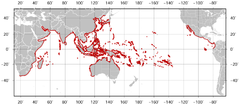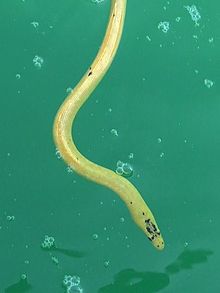Yellow-bellied sea snake
| Pelamis platura | |
|---|---|

| |
| yellow-bellied sea snake | |
| Scientific classification | |
| Kingdom: | |
| Phylum: | |
| Subphylum: | |
| Class: | |
| Order: | |
| Suborder: | |
| Family: | |
| Subfamily: | |
| Genus: | Pelamis |
| Species: | P. platura
|
| Binomial name | |
| Pelamis platura (Linnaeus, 1766)
| |

| |
| Yellow-bellied Sea Snake range.[3] | |
| Synonyms | |
| |

Pelamis platura, commonly known as the yellow-bellied sea snake, yellowbelly sea snake, or pelagic sea snake, is a species of sea snake found in tropical oceanic waters around the world, excluding the Atlantic Ocean. It is the only member of the genus Pelamis.
Description

- See snake scales for terminology used here
The body of this snake is compressed, posteriorly less than half the diameter of the neck; the body scales are juxtaposed, subquadrangular in shape, and in 23–47 rows around thickest part of body; ventral scales, 264–406 in number, are very small and, if distinct, divided by a longitudinal groove, but usually are indistinguishable from adjacent body scales. The head is narrow, with an elongated snout; head shields are entire, nostrils are superior, and nasal shields are in contact with one another; the prefrontal scale is in contact with second upper labial; one or two preoculars, two or three postoculars, and two or three small anterior temporals are present; seven or eight upper labials are found, with four or five below the eye, but separated from the border by a subocular. Colors of the snake are variable, but most often distinctly bicolored, black above, yellow or brown below, with the dorsal and ventral colors sharply demarcated from one another; ventrally, there may be a series of black spots or bars on the yellow or brown background, or the yellow may extend dorsally so there is only a narrow middorsal black stripe, or a series of black crossbars (M.A. Smith, 1943: 476–477, gives more complete descriptions of the color pattern variants). Total length for males is up to 720 millimetres (28 in), for females up to 880 millimetres (35 in); tail length for males is up to 80 millimetres (3.1 in), females up to 90 millimetres (3.5 in).
Habits
These snakes breed in warm waters; they are ovoviviparous with a gestation period of about six months. According to Ditmars, females bear live young in tidal pools.[6] They are helpless on land, and they sometimes form large aggregations of thousands in surface waters. These snakes use their neurotoxic venom against their fish prey. No human fatalities from envenomation are known.
As they live only in the ocean, they have to get all of their food and water there. However, they do not have the ability to filter all the salt from seawater, although they can do it for food. To survive severe dehydration, they wait for months until the rainy season, when rain water sits on top of the heavier saltwater below, then drink the surface water with lower salt concentration.[7]
Distribution
The yellowbelly is the most widely distributed sea snake and is capable of living and giving birth entirely in the open sea (it is totally pelagic), being found in all coastal waters around the rim of the Pacific Ocean except Alaska south to southern California, and in the coastal waters of the Indian Ocean from the Persian Gulf eastwards. It is the only sea snake to have reached the Hawaiian Islands.[8] The sea snake has also been reported around the shores of New Zealand,[9] a country that would otherwise be free of snakes were it not for the infrequent visits of yellowbellies and banded sea kraits.[10]
The yellowbellied sea snake (Pelamis platura, previously known as Pelamis platurus) has also been reported to occur in the Agulhas Current along the east coast of Southern Africa. A specimen was found washed ashore (01-09-2014) after a storm and deposited on the sandy beach at Boesmansrivermouth, (near Port Alfred), Easter Cape Province, South Africa. Also see references in "The Living Shores of Southern Africa", Margo and George Branch, Page 130 - 131, Macmillan South Africa (Publishers), Johannesburg and "Snake versus Man" Johan Marais, page 50 - 51, C. Struik Publishers, Cape Town.
Yellowbellies (and all other sea snakes) are not found in the Atlantic or Mediterranean, though the water there is warm enough. Yellowbellies require a minimum of 16–18 °C to survive long term.[11] Yellowbellies have not migrated around the southern tips of South America or South Africa because water temperatures are too cool.
A land bridge formed (at Panama) between North and South America about 3 million years ago, making it impossible for them to enter the Caribbean Sea from the Pacific. If they had reached the eastern Pacific Ocean before the land bridge formed, they would almost certainly be found now in the Atlantic. The Panama Canal has not made a crossing of the isthmus possible because it is fresh water.
They do not live in the Red Sea because of its excessive salinity.
Evolution
The yellowbelly seems to have evolved from the terrestrial elapids of Asia and Australia about 10 million years ago. This air-breathing sea snake has developed a flat, oar-like tail and valved nostrils since leaving the land millions of years ago.[12][13]
Taxonomy
Sea snakes are closely related to the venomous Australian snakes of the family Elapidae, but are sometimes classified in a separate family, Hydrophiidae. Two subfamilies have been listed in the past, the sea kraits (Laticaudinae), and the true sea snakes (Hydrophiinae), though recent work suggests this subfamilial division may be inappropriate.[14]
In 1766, Linnaeus published the original description of the yellow-bellied sea snake, naming it Anguis platura (Anguis meaning snake). In 1803, Daudin created the new genus Pelamis and assigned this species to it, referring to it as Pelamis platuros. In 1842, Gray described what he thought was a new species and called it Pelamis ornata (subsequently P. ornata became a synonym of P. platura). The word Pelamis is a feminine noun and means young or small tunny fish. In 1872 Stoliczka introduced the name Pelamis platurus (still the most used scientific name by scientists today), but used the incorrect ending -us instead of -a which a feminine noun requires.[15] There are a few recent examples of scientists' beginning to use the grammatically correct name Pelamis platura, e.g., Bohme 2003 and the Reptile Database with its page headed Pelamis platura (Linnaeus, 1766), which includes an extensive synonymy of the different scientific names which have been used for the yellowbelly sea snake.[16]
Name
The genus name Pelamis is derived from the Ancient Greek word for "tunny fish", which presumably refers to the habitat or what Daudin thought they ate. The specific name platurus is a combination of the Ancient Greek words platys "flat" and oura "tail", referring to the flattened tail.
Venom
The venom of this species is highly potent, like other sea snakes.[17] The subcutaneous LD50 of the venom is 0.067 mg/kg and the venom yield per bite is 1.0–4.0 mg.[18][19]
Antivenom
Sea snake venom can cause damage to skeletal muscle with consequent myoglobinuria, neuromuscular paralysis or direct renal damage. The venoms of significant species of sea snake are neutralised with Commonwealth Serum Laboratories Ltd (of Melbourne, Australia) sea snake (Enhydrina schistosa) antivenom. If that preparation is not available, tiger snake or polyvalent antivenom should be used. No deaths have been recorded from bites in Australian waters.[20][21] The E. schistosa antivenom was tested specifically on Pelamus platurus, and it effectively neutralised the venom.[22]
See also
Cited references
- ^ Template:IUCN2010.4
- ^ Wikispecies
- ^ International Union for Conservation of Nature (IUCN) 2010. Pelamis platura. In: IUCN 2015. The IUCN Red List of Threatened Species. Version 2015.2. http://www.iucnredlist.org. Downloaded on 19 July 2015.
- ^ Boulenger, G.A. 1896. Catalogue of the Snakes in the British Museum (Natural History). Volume III., Containing the Colubridæ (Opisthoglyphæ and Proteroglyphæ)... Trustees of the British Museum (Natural History). London. pp. 266–268.
- ^ The Reptile Database. www.reptile-database.org.
- ^ Schmidt, K.P. & D.D. Davis. 1941. Field Book of Snakes of the United States and Canada. G.P. Putnam's Sons. New York. p. 280.
- ^ http://rspb.royalsocietypublishing.org/content/281/1782/20140119
- ^ Liptow, J. 1999. "Pelamis platurus" (On-line), Animal Diversity Web. Accessed June 23, 2007 at [1]
- ^ "Swimmers told not to be surprised of poisonous sea snake". Waikato Times. Hamilton, New Zealand: Fairfax New Zealand. 4 January 2012. Retrieved 26 April 2012.
- ^ Natural History Information Centre, Auckland War Memorial Museum. "Natural History Questions". Auckland War Memorial Museum | Tamaki Paenga Hira. Auckland, New Zealand: Auckland War Memorial Museum. Q. Are there any snakes in New Zealand?. Retrieved 26 April 2012.
- ^ (Dunson and Ehlert 1971).
- ^ The New York Times, published 24 April 1984, article by Sandra Blakeslea http://query.nytimes.com/gst/fullpage.html?res=9903E2DD1238F937A15757C0A962948260&sec=health&spon= Accessed May 2008
- ^ Linnaeus 12th edition.
- ^ CSL Antivenom Handbook – Sea Snake Antivenom
- ^ Tropical zoology 13:327–329, 2000, The gender of the genera ... Pelamis Daudin 1803 (hydrophiidae) B Lanza and S, Boscherini – Accessed online May, 2008
- ^ Pelamis platura at the Reptarium.cz Reptile Database. Accessed May 2008
- ^ SnakeBiteTemplate3.pmd
- ^ LD50 value of venomous snakes
- ^ [2] LD stands for "Lethal dose".
- ^ https://www.flyingdoctor.net/IgnitionSuite/uploads/docs/snakebite.pdf Management of snake bites in Australia and Papua New Guinea. Accessed May 2008
- ^ http://www.emedicine.com/emerg/topic543.htm Accessed May 2008
- ^ http://www.ajtmh.org/cgi/content/abstract/23/1/135 Published 1973. Accessed May 2008.
Other sources
- Ditmars, R.L. 1936. The Reptiles of North America. Doubleday, Doran & Co. New York. 476 pp.
- Hecht, M. K., Kropach, C. and Hecht, B. M. 1974 Distribution of the yellow-bellied sea snake Pelamis platurus, and its significance in relation to the fossil record. Herpetologica 30: 387–395.
- Kropach, C. 1975 The yellow-bellied sea snake, Pelamis, in the eastern Pacific. Pp. 185–213 in: Dunson, W., ed., The Biology of Sea Snakes. Univ. Park Press, Baltimore, xi + 530 pp.
- Smith, M.A. 1943. The Fauna of British India, Ceylon and Burma, including the Whole of the Indo-Chinese Sub-region. Reptiles and Amphibians. Vol. III. – Serpentes. Taylor & Francis. London. 583 pp.

